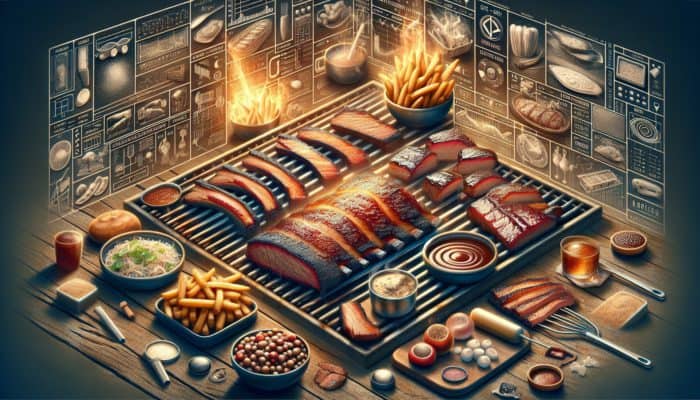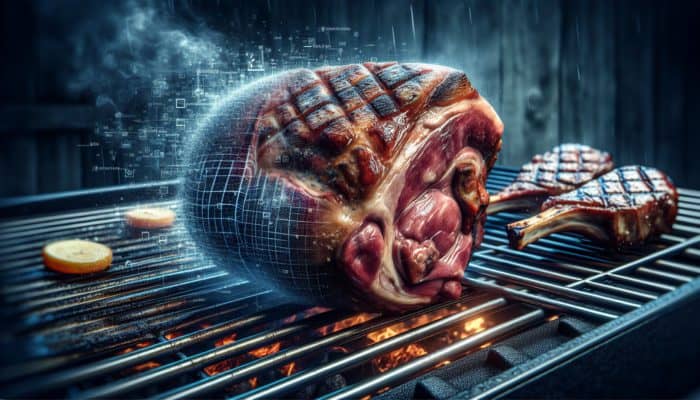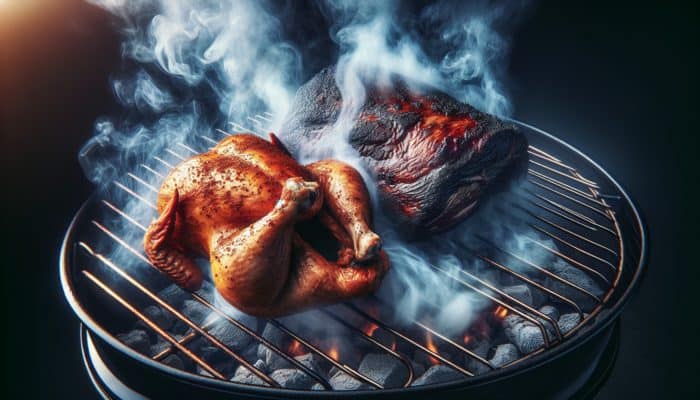Explore an Extensive Selection of BBQ Meats to Transform Your Grilling Experience
Unleash the Flavours of Prime Beef Cuts for an Exceptional BBQ

When imagining an ideal BBQ, selecting the finest beef cuts is crucial, as they possess the ability to elevate your grilling experience into a remarkable culinary journey. Cuts such as brisket and ribs are particularly esteemed for their unique flavour profiles and require specialised cooking methods to fully realise their potential. The acclaim of brisket stems from its exceptional marbling, which necessitates a low-and-slow cooking technique. Maintaining a temperature of 225-250°F for approximately 1 to 1.5 hours per pound allows the connective tissues to break down, resulting in tender, juicy beef that simply melts in your mouth. Meanwhile, ribs can be transformed through the perfect blend of spice rubs and sauces, with baby back ribs requiring 5-6 hours at 225°F, while spare ribs may take up to 7 hours. Mastering these cooking techniques is essential for any BBQ enthusiast keen on impressing their friends and family.
The significance of a meticulously crafted seasoning rub cannot be overstated. A well-seasoned brisket can drastically enhance your BBQ experience, making the wait truly worthwhile. Employing the “Texas Crutch” technique—where you wrap the brisket in foil after a few hours of cooking—can help to retain moisture and expedite cooking time while ensuring that essential melt-in-your-mouth tenderness remains intact. This technique is vital for achieving the best possible flavour and texture in your BBQ meats, making it a must-try for every grilling aficionado.
Delight in the Rich and Savoury Flavours of BBQ Pork Cuts
Pork occupies a cherished position in the BBQ realm, featuring beloved options such as pulled pork and pork chops that consistently bring joy to the table. Pulled pork, typically sourced from the shoulder or butt, necessitates an extended cooking duration to break down tough connective tissues, yielding the tender, succulent texture that BBQ lovers desire. Cooking at a low temperature of approximately 225°F can require between 8 to 12 hours, varying with the size of the cut. The result is irresistibly tender meat, ideal for stuffing into sandwiches or sliders, making it a family favourite at gatherings.
In contrast, pork chops represent a quicker grilling alternative. They can be grilled directly over high heat, requiring about 4-6 minutes per side, depending on thickness, making them an excellent choice for those seeking a swift yet satisfying BBQ meal. Grasping the different cooking times for varied pork cuts is crucial to sidestep the traps of overcooking or undercooking, both of which can lead to a disappointing dining experience.
Seasoning plays a pivotal role in accentuating the flavours of pork dishes. A perfectly balanced sweet and tangy sauce can amplify the natural flavours without overwhelming them. For BBQ novices, mastering the timing for cooking pork cuts can significantly elevate your grilling skills and leave your guests thoroughly impressed with the delicious outcomes that follow.
Achieve Grilling Excellence with Chicken Mastery
Chicken is an incredibly versatile protein that adapts well to a variety of grilling techniques, from whole birds to wings, each cut necessitating distinct cooking times to ensure both safety and flavour. A whole chicken typically requires around 1.5 to 2 hours at 350°F, ensuring that the internal temperature reaches the crucial safety benchmark of 165°F. Achieving this temperature is not only vital for food safety but also guarantees a beautifully cooked bird that will please any palate.
For individual chicken portions, such as thighs or breasts, the cooking time is considerably shorter—approximately 20-30 minutes, depending on size. Chicken wings truly shine when grilled over high heat for about 20-30 minutes, resulting in a delectably crispy exterior. The secret to delicious chicken lies in consistently monitoring the internal temperature with a meat thermometer, ensuring that your dish is not only safe to consume but also remains juicy and flavourful throughout the cooking process.
Brining chicken prior to grilling can yield remarkable results, as it helps to infuse moisture and flavour into the meat. Understanding the necessary cooking times for various cuts is vital to achieving a perfectly cooked meal without the risk of drying out the meat, ensuring a delightful experience for everyone at the table.
Indulge in Succulent Lamb Cuts Ideal for BBQ Aficionados

Lamb is a luxurious and rich choice that requires careful attention to cooking times in order to achieve optimal tenderness and flavour. Cuts such as shoulder and chops have distinct cooking time requirements that must be adhered to. A lamb shoulder is best prepared using a slow cooking technique at 250°F for approximately 4-6 hours, allowing the meat to become exquisitely tender, making it a favourite among BBQ enthusiasts.
Conversely, lamb chops are similar to cooking steaks and can be grilled rapidly over high heat for about 4-5 minutes per side, depending on thickness. Understanding the correct cooking times for lamb is essential to avoid drying out the meat while capturing the unique flavour that makes lamb an exceptional choice for BBQ lovers.
Utilising marinades rich in herbs and spices can beautifully complement lamb. Classic pairings such as fresh rosemary and garlic can elevate your dish to an entirely new level. Mastering the cooking times and techniques for lamb will undoubtedly enhance your BBQ skillset, impressing your guests and adding exciting variety to your grilling repertoire.
Essential BBQ Techniques to Hone Your Grilling Skills
Utilising Direct Heat for Quick Grilling Triumphs
Direct heat grilling is an excellent method for rapidly cooking popular items such as burgers, hot dogs, and chicken breasts. This technique entails placing food directly over the flame, resulting in a beautifully seared exterior and an irresistible smoky flavour that enhances the overall experience. Timing is crucial with this method, as most items only require a few minutes per side. For instance, burgers typically need about 4-5 minutes per side for a medium-rare finish, while chicken breasts can take approximately 6-8 minutes to achieve perfection.
A common pitfall when grilling over direct heat is the failure to properly manage heat, which can lead to uneven cooking and lacklustre results. Always preheat your grill to ensure that you achieve the perfect sear and prevent food from sticking, which is essential for a successful BBQ experience.
For those aspiring to achieve various levels of doneness, it is vital to comprehend the specific cooking times associated with each type of meat. Employing a meat thermometer will assist you in attaining your desired doneness without risking overcooking, ensuring that every bite is cooked to perfection.
Mastering Indirect Heat Grilling for Larger Cuts of Meat

Indirect heat grilling is the preferred method for larger cuts of meat that require extended cooking times. This technique involves positioning food away from the direct flame, allowing it to cook slowly and evenly. For example, a whole chicken or a brisket is optimally cooked using this method, typically at temperatures ranging from 225°F to 275°F, which allows for a richer flavour profile to develop.
Cooking durations will vary according to the size of the meat, but a general guideline is approximately 30-40 minutes per pound. This approach not only ensures even cooking but also helps retain the meat’s juices, resulting in an exceptionally tender and flavourful final product.
To further enhance flavour during indirect grilling, consider adding wood chips to your fire for that perfect smoky finish. This added layer of flavour combined with extended cooking time will create a BBQ experience that is both memorable and delicious, leaving your guests eagerly anticipating more.
Embrace the Depth of Flavours through Smoking Meat for BBQ Excellence
Smoking is a cherished BBQ technique that involves cooking meat at low temperatures over an extended period, often incorporating wood chips to infuse distinct flavours into the meat. This process can take several hours—ranging anywhere from 5 to 12 hours, depending on the type of meat and the desired intensity of smoke flavour. The low and slow method allows the meat to absorb the smoke while becoming tender and bursting with flavour.
Brisket and pork shoulders are prime candidates for smoking, typically cooked at around 225°F for an extended duration. This slow cooking method permits the smoke to permeate the meat, creating a rich and complex flavour profile that is truly unmatched. While smoking may appear daunting, the delicious results are well worth the effort, rewarding your patience with an incredible BBQ experience.
The choice of wood used for smoking can significantly influence the flavour profile, with options like hickory, mesquite, and applewood being particularly popular. Understanding the balance of cooking time, temperature, and smoke flavour will result in a BBQ experience that impresses any crowd, elevating your grilling skills to new heights.
Mastering Temperature Control for BBQ Perfection
Understanding Grill Temperature for Optimal Cooking Success
Maintaining the correct grill temperature is critical for a successful BBQ. Different types of meat have specific optimal temperature ranges for cooking, ensuring both safety and flavour. For example, beef is best cooked around 130-160°F for medium-rare to medium doneness, while chicken must reach a minimum internal temperature of 165°F to be safe for consumption, making temperature control essential for achieving delicious results.
Utilising a reliable grill thermometer is crucial for monitoring temperature, enabling you to make adjustments as needed. Moreover, understanding the type of grill you are using—whether it is gas, charcoal, or electric—can enhance your mastery of temperature control and improve your grilling outcomes.
Hot and cold spots on the grill can lead to uneven cooking, which can be extremely frustrating. Rotating your meat and being conscious of where you place it on the grill can help mitigate these issues, ensuring everything cooks uniformly and to perfection, thereby elevating your BBQ skills to the next level.
Confirming Meat Temperature for Safety and Quality
Utilising a meat thermometer to check internal temperatures is imperative for ensuring food safety and achieving the desired doneness. Each type of meat has specific temperature thresholds that must be met. For example, ground meats should reach 160°F, beef steaks can vary from 130°F for rare to 160°F for well-done, while pork should reach 145°F to ensure both safety and optimal flavour.
When measuring temperature, it is essential to insert the thermometer into the thickest part of the meat, avoiding contact with bones, which can yield inaccurate readings. Understanding these specific temperatures not only ensures safety but also aids in achieving the desired texture and juiciness of your meats, significantly enhancing the quality of your BBQ meals.
For those new to BBQ, investing in a high-quality meat thermometer can be a game-changer, allowing you to cook with confidence. Achieving the right internal temperature is one of the most critical aspects of BBQ success, making it an essential tool in your grilling arsenal.
Adjusting to Environmental Conditions for Consistent Cooking Results
Ambient conditions, such as weather and altitude, can greatly influence cooking times and outcomes. For instance, windy days can create temperature fluctuations, necessitating adjustments to cooking times. Cooking at higher elevations can result in longer cooking durations due to lower air pressure, meaning that meats may require additional time to reach their ideal cooking temperature.
If you’re grilling outdoors during colder months, consider wrapping meats in foil to help retain heat and moisture. On the other hand, on hot summer days, you might want to adjust your cooking strategy to prevent overcooking or drying out your dishes, ensuring that every BBQ session is a triumphant success.
Being aware of these environmental factors can enable you to plan your BBQ more effectively, leading to consistent results regardless of the conditions. This knowledge can boost your confidence and skill as a BBQ enthusiast, resulting in memorable meals every time.
Utilising Temperature Probes for Precise Cooking
Employing accurate temperature probes can assist in monitoring cooking temperatures precisely, ensuring that your meat is cooked evenly across various zones of the grill. Temperature probes can be either wired or wireless, allowing you to keep an eye on the temperature from a distance without having to hover over the grill.
Numerous advanced models come equipped with alerts that notify you when your meat has reached the desired temperature, enabling you to concentrate on other tasks while cooking. This technology can be particularly beneficial when smoking meats, as maintaining consistent temperatures is critical during lengthy cooking sessions, ensuring that everything is cooked to perfection.
Investing in high-quality temperature probes can significantly enhance your BBQ experience, granting you greater control over the cooking process and increasing the likelihood of a successful cook every time you fire up the grill.
Techniques for Adjusting Temperature During Grilling
Mastering techniques such as vent control and heat deflection is essential for fine-tuning grill temperatures for optimal cooking results. In charcoal grills, adjusting the vents can increase or decrease airflow, thereby altering temperature levels.
Adding or removing coals can also effectively regulate heat. For gas grills, utilising multiple burners can create zones of varying temperatures, allowing for both direct and indirect cooking methods to be executed simultaneously. This flexibility can greatly enhance your BBQ capabilities.
Becoming familiar with these techniques will empower you to achieve the right cooking temperatures consistently, whether you are grilling burgers or smoking a succulent brisket. This mastery can elevate your BBQ skills and impress your guests, making every gathering a delightful success.
Avoid Common BBQ Mistakes for an Unforgettable Experience
Steer Clear of Overcooking Your Meats
Overcooking is a common pitfall that can ruin even the finest cuts of meat. Understanding and meticulously monitoring cooking times is crucial for preventing dryness and ensuring that your BBQ experience is enjoyable. For instance, brisket can easily become tough if cooked for too long, while chicken can dry out quickly if left unattended, leading to disappointing meals.
To avoid the overcooking trap, it is essential to invest in a reliable meat thermometer. Regularly checking the internal temperature will assist you in determining when the meat is just right. Moreover, techniques such as wrapping meat in foil during the final stages of cooking can help retain moisture, resulting in a juicy and flavourful outcome.
Learning to recognise visual and textural cues can also help prevent overcooking. For example, meat should feel firm yet springy when done, and juices should run clear. Mastering these indicators will enhance your BBQ success and boost your cooking confidence, ensuring that every meal is a hit.
Avoid Undercooking for Health and Safety
Undercooking poses serious health risks, particularly with poultry and pork. Ensuring that meats reach safe internal temperatures is essential to prevent foodborne illnesses. For chicken, this means cooking it to at least 165°F, while pork should reach 145°F to ensure safety, flavour, and texture.
To guarantee thorough cooking, using a meat thermometer is crucial. Understanding the specific safe cooking temperatures for each type of meat allows you to prepare food safely while also preserving its flavour and appealing texture, ensuring that your BBQ gatherings are enjoyable and safe for everyone.
Visual cues can also assist in determining doneness. For example, chicken should no longer appear pink in the centre, and juices should run clear when pierced. Avoiding undercooked meats is crucial for a safe and enjoyable BBQ experience, demonstrating your commitment to quality cooking.
Managing Inconsistent Heat for Uniform Cooking Results
Managing hotspots and cold spots on the grill can significantly impact cooking results, leading to uneven doneness and frustrating outcomes. Understanding your grill’s mechanics and conducting test runs can help identify these areas, allowing you to adjust your cooking strategy accordingly.
Rotating your food during cooking can help mitigate these issues, ensuring more even heat distribution and consistent results. Additionally, keeping the lid closed while cooking can help maintain steady temperatures, enhancing your results and cooking efficiency.
Adjusting your placements based on identified hotspots can lead to a more successful grilling experience, ultimately refining your BBQ skills over time and making you a more confident cook.
The Importance of Using the Right BBQ Tools
Selecting the appropriate utensils and equipment is vital for enhancing BBQ results and preventing damage to both food and grill. For instance, using metal tongs instead of forks helps to avoid the escape of juices, keeping your meat moist and flavourful. This simple adjustment can make a significant difference in the quality of your BBQ.
Investing in a quality set of grilling tools can markedly improve your overall experience. Consider tools like grilling baskets for smaller items, which can prevent food from falling through the grates, and sharp knives for easy slicing and serving.
Avoid using non-BBQ-specific tools, as they can lead to accidents and damage during your grilling sessions. Ensuring you have the right tools on hand will streamline your BBQ process and make it more enjoyable, enabling you to focus on creating delectable meals for your friends and family.
Essential Tools and Accessories for an Outstanding BBQ Experience
Reliable Thermometers for Precise Cooking
Thermometers are indispensable for obtaining accurate temperature readings, guiding cooking times, and ensuring food safety throughout your BBQ. Digital instant-read thermometers offer quick and precise readings, allowing you to monitor your meat without losing valuable heat.
Investing in a quality thermometer can greatly enhance your BBQ experience, providing peace of mind that your food is cooked to perfection. Some advanced models even feature Bluetooth capabilities, enabling you to monitor temperatures remotely, which is incredibly convenient during longer cooking sessions.
Understanding how to properly use and calibrate your thermometer is also essential. Regularly checking its accuracy can ensure that you are always cooking with confidence and precision, minimising the risk of undercooked or overcooked meats.
Timers to Keep Your Cooking on Track
Setting timers is crucial for managing long cooks, ensuring that you check on your food at appropriate intervals. An easy-to-use kitchen timer can help you keep track of cooking times, especially for lengthy smokes or roasts, preventing overcooking or burning.
Utilising timers can also prevent common pitfalls in BBQ, allowing you to focus on other tasks while still ensuring that your food receives the attention it deserves. Having reminders in place is invaluable for a smooth cooking process.
Consider using timers that offer multiple settings, enabling you to manage several items simultaneously. This feature can be particularly helpful during busy BBQ gatherings, ensuring that everything is cooked to perfection and ready to serve at the right time.
Grilling Baskets for Versatile Cooking Options
Grilling baskets are a versatile tool for handling smaller items like vegetables and seafood that require frequent turning to achieve even cooking. These baskets allow for improved airflow around the food, ensuring that your items are grilled to perfection without falling through the grates, thereby enhancing your BBQ experience.
Moreover, these baskets can enhance flavour by allowing food to be coated in marinades during grilling. Investing in a high-quality grilling basket can significantly improve your BBQ experience, ensuring that no delicious morsel is left behind.
Additionally, they simplify cleanup, minimising mess and ensuring smooth transitions between dishes, making your grilling session more enjoyable overall. This added convenience allows you to focus on relishing your time with friends and family rather than worrying about the cooking process.
Versatile Tongs for Safe and Efficient Grilling
Tongs are an essential tool for safely handling hot food on the grill. They offer a firm grip, allowing for easy flipping and turning, which is crucial for preventing food from sticking and ensuring even cooking across all items.
Using tongs instead of forks helps retain juices, resulting in a more succulent final product that showcases your grilling skills. Opting for high-quality, heat-resistant tongs can significantly enhance your grilling experience, providing better manoeuvrability and control during cooking.
Tongs come in a variety of designs, so selecting a pair that feels comfortable in your hand can also contribute to a more enjoyable BBQ experience, allowing you to grill with confidence.
Durable Spatulas for Efficient Food Handling
Spatulas are ideal for lifting and turning larger food items on the grill, ensuring even cooking while preventing sticking. A good grilling spatula should be sturdy yet flexible, allowing for easy manoeuvrability when handling various foods.
Using a spatula can also assist with delicate items like fish, which require a gentle touch to flip without breaking apart. Finding a spatula that suits your grilling style can greatly enhance your overall results and streamline the cooking process.
Ensure that your spatula is constructed from heat-resistant materials to withstand high temperatures, making it a reliable tool for all your BBQ needs. A high-quality spatula will serve you well for many grilling sessions to come.
Comprehensive BBQ Cooking Time Charts for Every Type of Meat
Understanding Cooking Times for Beef and Pork for Perfect Results
Familiarity with the average cooking times for various cuts of beef and pork is essential for any BBQ enthusiast. For beef brisket, you should anticipate approximately 1 to 1.5 hours per pound when cooked at 225°F, ensuring that it becomes tender and bursting with flavour. Ribs typically require around 5-7 hours at the same temperature for optimal results, giving you that iconic BBQ flavour.
On the pork side, a pork shoulder designated for pulled pork can take 8-12 hours at 225°F, allowing the connective tissue to break down into melt-in-your-mouth goodness. In contrast, pork chops are much quicker to prepare, needing only about 4-6 minutes per side over direct heat. These cooking times can vary based on grill temperature, meat thickness, and desired doneness, making it essential to monitor your BBQ carefully.
Utilising resources like cooking time charts can provide a quick reference guide, simplifying your BBQ planning and ensuring you serve perfectly cooked meats every time, delighting your guests with each delectable bite.
Perfect Cooking Times for Poultry to Ensure Safety and Flavour
Different chicken parts require varying cooking times for optimal results. A whole chicken should be cooked for about 1.5-2 hours at 350°F, while chicken thighs and breasts typically take around 20-30 minutes. Wings require similar timing, approximately 20-30 minutes, depending on the cooking method used, making proper timing crucial for a successful BBQ.
Utilising a poultry cooking time chart can help ensure that you achieve juicy, flavourful chicken without any risk of undercooking. This knowledge is especially beneficial for those hosting BBQ gatherings, guaranteeing that the chicken will be a crowd-pleaser and a highlight of the meal.
Understanding cooking times for poultry is not only essential for safety but also for flavour, allowing you to serve a delicious meal that everyone will enjoy without any worry.
Guidelines for Grilling Seafood and Vegetables to Achieve Delicious Results
Grilling seafood and vegetables requires specific guidelines to achieve the desired doneness and flavour. Fish fillets typically take around 8-10 minutes per inch of thickness at medium heat, while shrimp can cook in as little as 2-3 minutes per side, making them a quick and tasty option for your BBQ.
Vegetables vary widely in their cooking times, with denser options like potatoes needing around 20-30 minutes, while softer vegetables like zucchini can take only 5-10 minutes to reach that perfect tenderness. Following these cooking times is crucial for ensuring quality and flavour, making it essential to adhere to guidelines for optimal results during your grilling sessions.
Using a cooking time chart for seafood and vegetables can streamline your BBQ experience, ensuring that everything cooks harmoniously and flavours shine through, creating an enjoyable meal for all.
Frequently Asked Questions About BBQ Techniques
What is the ideal temperature for grilling beef brisket?
The ideal temperature for grilling beef brisket is around 225-250°F, allowing for a low and slow cook that results in tender, mouthwatering meat that is sure to impress.
How long should I cook pork chops on the grill for best results?
Pork chops typically take about 4-6 minutes per side on direct heat, depending on their thickness, to achieve optimal doneness and flavour that satisfies every palate.
What internal temperature must chicken reach to ensure safety?
Chicken should reach an internal temperature of 165°F to ensure that it is safe to eat and thoroughly cooked, minimising health risks and ensuring a delicious meal.
How can I tell when my ribs are fully cooked?
Ribs are fully cooked when they reach an internal temperature of approximately 190-203°F, and the meat is tender, easily pulling away from the bone, showcasing your grilling prowess.
Is it possible to grill vegetables directly on the grill?
Yes, you can grill vegetables directly on the grill, but using a grilling basket is advisable to prevent them from falling through the grates, ensuring even cooking and delicious results.
What’s the best method to avoid overcooking meat?
Using a reliable meat thermometer to monitor internal temperatures is the best way to avoid overcooking meat, ensuring it reaches the desired doneness without drying out, resulting in juicy and flavourful dishes.
How long does it typically take to smoke a pork shoulder?
Smoking a pork shoulder usually takes 8-12 hours at 225°F, depending on its size and desired tenderness, making it a time-consuming but rewarding process for BBQ lovers.
What steps should I take if my grill has hot spots?
To manage hot spots on your grill, rotate your food during cooking and adjust your meat placement to ensure even cooking across all items, leading to a more successful BBQ experience.
How can I keep my BBQ tools in top condition?
Regularly cleaning your BBQ tools after each use and storing them in a dry, safe place will help maintain their longevity and performance, ensuring they’re ready for your next grilling session with ease.
What advantages does brining chicken offer?
Brining chicken enhances its flavour and moisture, resulting in juicier meat that is less likely to dry out during cooking, making it a popular technique among BBQ enthusiasts seeking perfection.
Join Us on Facebook for More BBQ Tips and Tricks!
The Article Understanding BBQ Cooking Times for Beginners: A Comprehensive Guide appeared first on https://pitmastersarsenal.com
The Article BBQ Cooking Times for Beginners: Essential Guide Was Found On https://limitsofstrategy.com

